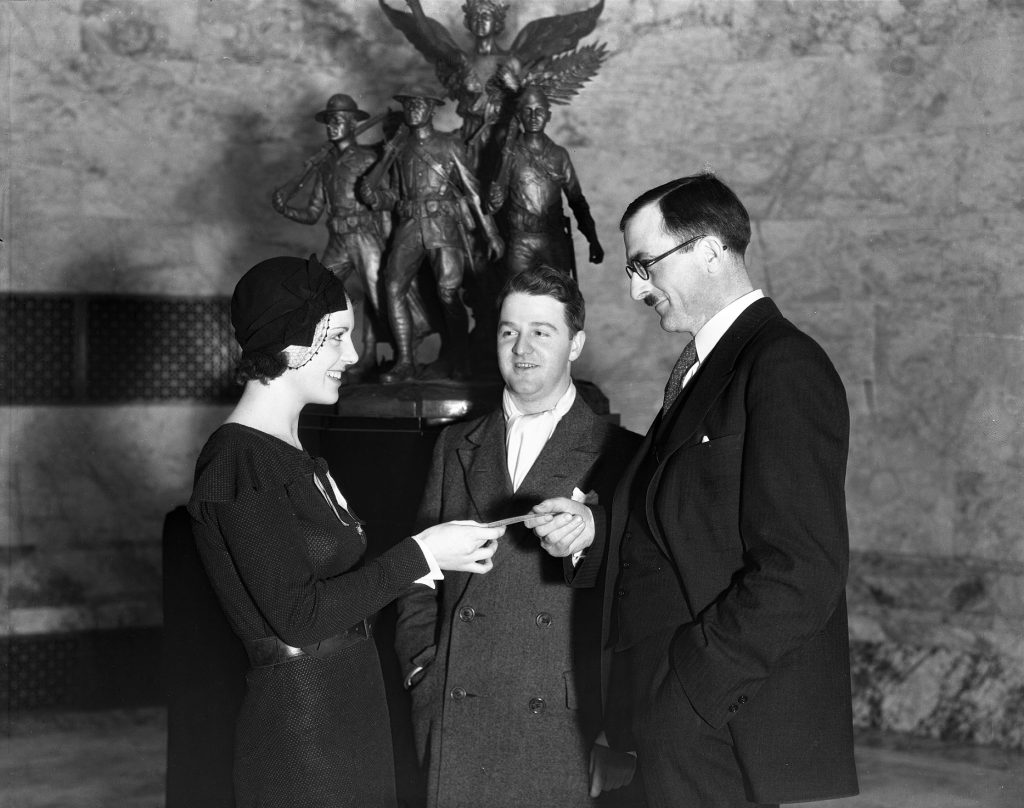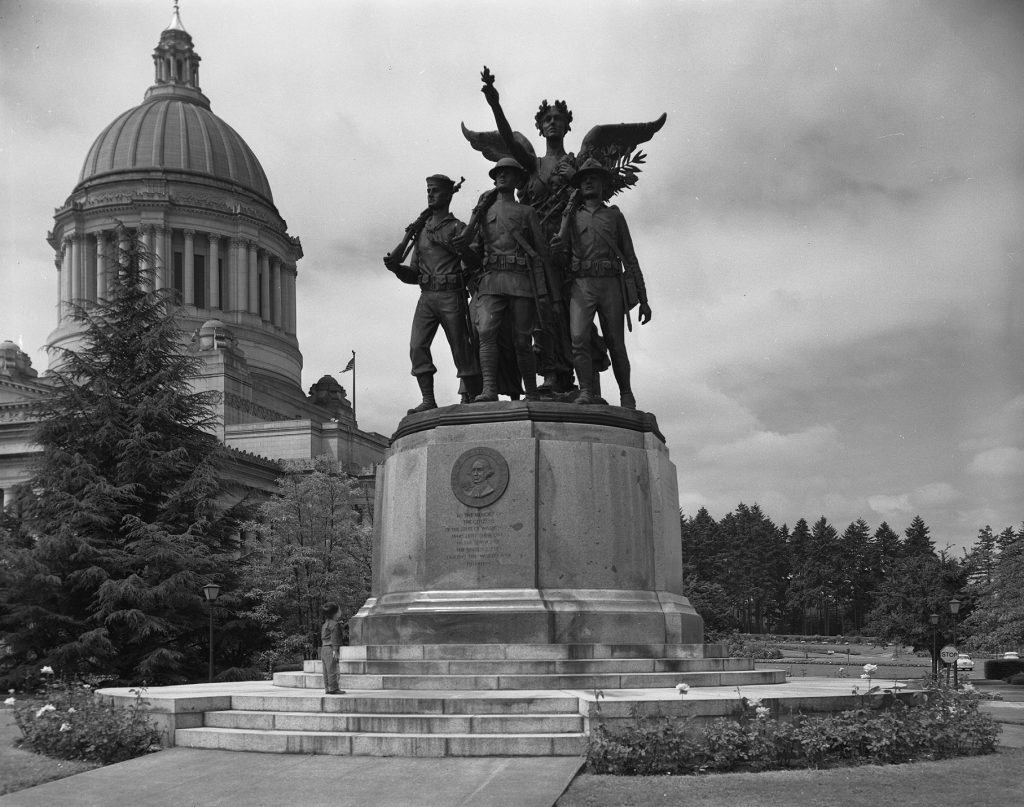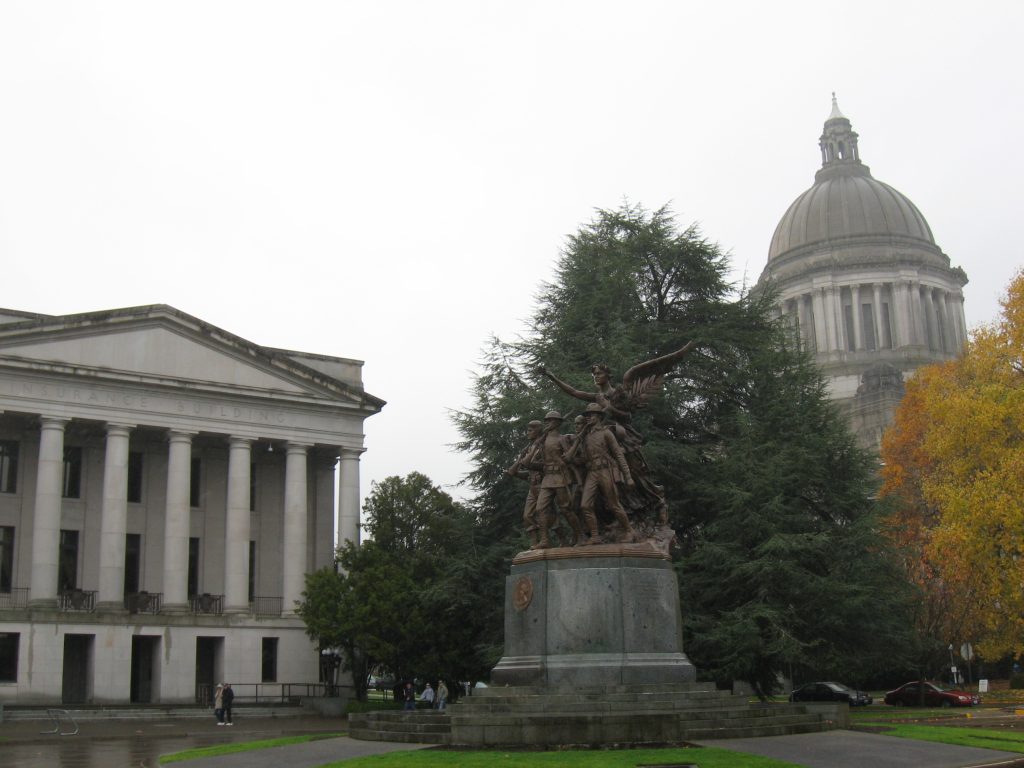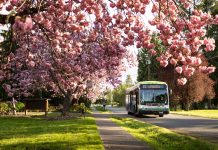Located in the center of the roundabout near the Insurance Building and northeast of the Legislative Building, the Winged Victory Monument on the Washington State Capitol Campus in Olympia honors Washington veterans who lost their lives in World War I.
Winged Victory Monument, Olympia
The monument depicts a soldier, sailor and marine marching, arms shouldered. A Red Cross nurse follows, a medicine kit slung over her shoulder. Behind them, a 12-foot-tall Nike – the ancient Greek goddess of victory – extends an olive branch over them in blessing and protection. Standing atop a 10-foot-tall granite base, the group symbolically marches east toward a distant horizon.
“To the memory of the citizens of the State of Washington,” reads the inscription on the east side of the memorial, “who lost their lives in the service of the United States during the World War 1917 – 1918.”
Planning a Washington State Veteran Monument
Soon after the war was over the state began discussing a war memorial. In 1919 Governor Ernest Lister proposed to the legislature a memorial, “In honor of the soldiers, sailors and marines from this state who lost their lives in the service by disease or on the battlefield at home or aboard in the present war with the Teutonic powers.” The same session passed a bill, appropriating $50,000 for the project. The memorial would go on the new capitol campus.
The artist selected to do the work was Alonzo Victor Lewis, 1886-1946, who was considered among the state’s foremost sculptors at the time. He attended the Chicago Academy of Art and worked in Tacoma, Los Angeles, New York City, Cuba and Mexico before opening a studio in Seattle in 1919. The sculptor was known for his portraits and monumental bronze statues. His classical, realistic style was considered the perfect choice for the state’s war memorial. Lewis had also created other war memorials – such as the Doughboy statue at Seattle’s Evergreen-Washelli Cemetery and the Sentinel monument in Centralia. In 1939 he was declared the sculptor laureate of Washington by the state legislature.

However, it would take years for the state to spend the money for the State Capitol Campus memorial. Initial plans for the monument were only approved in 1927. “If we get the grounds in time to do it,” State Lands Commissioner Clark Savidge wrote hopefully to Washington State Historical Society’s secretary W.P. Bonney, “the work can be taken up during the present biennium. It, of course, cannot be placed until the grounds are ready.”
But it would take far longer than that. Meanwhile the Capitol Campus was taking shape. The Temple of Justice, begun in 1912, was finished after World War I due to funding delays. The Insurance Building was completed in 1921. The Legislative Building opened in 1928.
Work on grading the campus was not approved until 1929. Governor Roland Hartley clashed with his fellow Capitol Commissioners over grading and road directions and even proposed relocating the planned “Victory Monument” to another location, near where the now demolished greenhouse would later be built. Grading work began in 1931 but the Great Depression put a stop to initial work.
Gracing the capitol’s foyer at this time was a scale model of the proposed monument, which the artist produced after a long delay of his own. He was not even formally commissioned to fabricate the monument until 1931. The sculpture was cast by the Roman Bronze Company of Long Island, New York.
Winged Victory was finally completed in 1938 and dedicated on Memorial Day, May 30. This ceremony was jointly sponsored by Olympia’s Alfred William Leach Post #3 of the American Legion and Ira L. Cater Post #138 of the Veterans of the Foreign Wars. The Gold Star mothers of the two young men that the posts were named for, Frances Leach and Cordelia Cater, unveiled the monument.
The Legion and VFW supported and endorsed the monument. The total cost was around $100,000, financed mostly by the sale of state timberlands. The rest was provided by a federal grant.

Restoration and Repair of the Winged Victory Monument
“Winged Victory” became a center for annual Memorial and Veterans Day commemorations. But time and weather took their toll. Its original rich warm brown finish darkened and dulled and became streaked with dirt. In 1979 the sculpture received a “light” sandblasting to clean the surface. By 1988 the monument was so badly stained it was cleaned and refinished with a brass powder in an acrylic base. This changed the sculpture to a golden color many locals remember.
However, this new paint job failed to protect the monument from corrosion. After years of planning, the sculpture was cleaned and restored in the summer of 2008. Holes were drilled to drain copious amounts of water and it was refinished back to its original appearance. The memorial was rededicated on October 14, 2008.

The monument is now annually cleaned and inspected for damage. It remains a focus of Memorial and Veterans Day events. “Their sacrifice,” Winged Victory inscriptions state for all to read, “was to vindicate the principles of peace and justice in the life of the world…They fought to safeguard and transmit to posterity the principles of justice, freedom, and democracy…Greater love hath no man than this, that a man lay down his life for his friend.”



















































